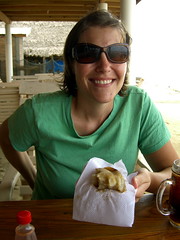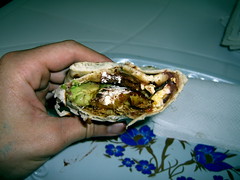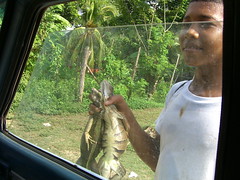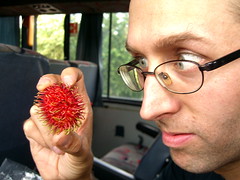Fellow volunteers Luke and Annie wrote an excellent blog entry about sustainable development - what it is, how it's done and other related issues. We Peace Corps volunteers think about this stuff a lot. I've been meaning to write a similar blog entry for some time, but they did a great job so I'll just point you to it:
http://lukeandannie.blogspot.com/2008/01/sustainable-development-work.html
UPDATE: They have another interesting post on the history of foreign influence in Honduras.
Monday, January 28, 2008
Friends on Sustainable Development
Posted by
Raphael
at
6:48 PM
1 comments
![]()
Saturday, January 12, 2008
Food
Some honduran food I've tried:
Sopa de Caracol
This is arguably the best-known Garifuna dish. It's a coconut milk-based soup with Caracol (conch) meat. I'm trying to track down a good recipe so I can make it for folks back home. All Garifuna soup is coconut milk-based, and you can get it with Conch, Shrimp, Fish, Crab or just plain. Served with tajadas (fried plantain or green banana) and rice.
Pan de Coco
Another Garifuna staple, Pan de Coco (Coconut Bread) doesn't actually taste like coconut. It's your basic dinner roll made with coconut milk instead of regular milk. There's a couple old Garifuna ladies in Trujillo who walk around carrying Pan de Coco, Pan de Yucca and Tableta de Coco in giant buckets on their heads.
Pan de Yucca
Pan de Yucca is not so much bread as semisolid pudding. Made with yucca, dulce de caña (molasses) and cinnamon, I can never resist buying one when I see one of the bread ladies in town.
Tableta de Coco
A dessert made of shredded coconut and dulce de caña. Very sweet, but very tasty.
Casabe
A traditional Garifuna flatbread made from mashed Yucca. It's hard and flavorless by itself, but very tasty when topped with garlic butter.
Calaguala
A juice that is made by an old Garifuna lady in Guadalupe. As far as I know, she's the only person in the area who sells the stuff. It's made from a fruit of the same name that grows wild in the mountains.
Guifiti
Guifiti is guaro (cane alcohol) or cheap rum infused with a secret mix of herbs. There are several bars/clubs in Cristales that sell their own homemade Guifiti, and each is a bit different.
Atol de Maiz
A sweet corn porridge made with, uh, corn, and dulce de caña and probably some other stuff too. It's served piping hot by a lady from San Martín (an outlying neighborhood in Trujillo). It would be great on a cold day, if we ever had one.
Baleada
The best known Honduran snack. Flour tortilla, refried beans, cheese and mantequilla (a semi-churned cream similar to sour cream). Especiales (specials) come with eggs and/or meat, too. There are great baleadas to be had in certain parts of Honduras, notably Santa Barbara, Tela and Comayagua (of the places I've been). Trujillo has them, but they're nearly as good.
Plato Típico
Typical plate. Beans, queso seco (honduran cheese), eggs and/or meat, corn tortillas, tajadas and mantequilla.
Machuca
Another Garifuna dish. Machuca is mashed plantain served with seafood soup. You take a bit of the mashed plantain (it's the consistency of lumpy play-doh) on your spoon and then dip it in the soup and eat it. I love the stuff.
Iguana
As in big lizards. Kids go into the mountains and catch them "by chasing them and jumping on top of them," according to my counterpart, Kenny. Then they take them home and cook them up and eat them. I had Iguana in Olanchito and am not in a hurry to have it again. But Kenny insists that the Garifuna way of preparing Iguana is far superior and that I shouldn't dismiss the dish until I've tried it.
Lichas
Lychees in English. I'd had these fruit before but they'd always been removed from the rind and pitted so I had no idea what they actually looked like. These things are sold by the bagfuls all over the North Coast. Lychee rinds litter the roads. I've never seen a lychee tree, so I'm not sure where they come from...
Posted by
Raphael
at
12:06 PM
2
comments
![]()
Saturday, January 5, 2008
The New Year
Yes, it's been a long time since I've updated. A big reason why is that the newness of everything is wearing off. The "Wow! I want to tell people about this!" moments are fewer and farther between. Which isn't to say they don't still happen, but there's just not enough of them to motivate me to write that often.
I spent Christmas through New Years Day in San Francisco, visiting friends and family. It was a wonderful trip. I was so glad to see so many of my favorite people in the world. It was hard to come back to Trujillo.
Most of the volunteers from my training group, myself included, have been going through a slump lately. Frustration, difficulties with motivation, loneliness, etc. Apparently this is pretty normal for volunteers at this point in their service, but it sure doesn't make it any easier.
It's becoming harder to overlook the daily frustrations - people not attending meetings, not returning phone calls, not carrying their weight, and so forth. And of course there's the power, water and bread outages.
But there is some hope for an upswing. I've got some promising projects lined up for 2008. My first six months in site were spent just getting to know people and trying to figure out my niche here. Now I have established some priorities and know what I want to work on. My three projects for the new year are:
1) Working with the HIV+ support group leaders to add more structure to the meetings and attract new members. Attendance right now is very low, and many newly diagnosed people living with HIV are not hearing about or attending the meetings.
2) Men's Health training with the naval and army bases outside of Trujillo.
3) HIV prevention workshops with high school kids.
If all goes well, hopefully I'll be busy and content by the time the rains stop in mid-February. If not, then it's going to be a long year.
Posted by
Raphael
at
11:06 AM
0
comments
![]()
Friday, January 4, 2008
No Bread, No Water
Bread and Water
There's no bread or water. Apparently there was a run on bread over new years and every store is out. No hamburger buns even.
More importantly, my apartment complex has no water. We ran out of water around the 16th of December. Luckily I was able to use the facilities at Brent's apartment and then I went home for the holidays on the 21st, so it didn't affect me that much. I figured that the water would be back by the time I returned.
When I got home on the 2nd, water came out of the faucets, so I assumed that everything was back to normal. Not so. Two days later, we were out of water again. Apparently the temporary reprieve was because one of my neighbors siphoned water from the tank of another house, but then said tank ran out of water as well.
Not having water for even 24 hours is not fun. First off, dirty dishes pile up and cooking at home is impossible, so you're limited to eating sandwiches or eating out. The former isn't possible since there's no bread in the entire town. The toilet gets pretty stinky even if you're limiting yourself to #1 and doing #2 elsewhere. And since there's no water for showers (or even bucket baths) you tend to get pretty stinky, too.
But this situation reveals a big difference between myself and Hondurans. I sat at home cursing the faulty honduran plumbing and wishing I was back in the States. On the other hand, my neighbors not only rigged the aforementioned siphon, but also dug up the water line for our house the figure out where the problem was. So far the digging hasn't yielded a solution (just a giant hole in our front yard) but at least they're trying.
Posted by
Raphael
at
11:03 AM
0
comments
![]()









